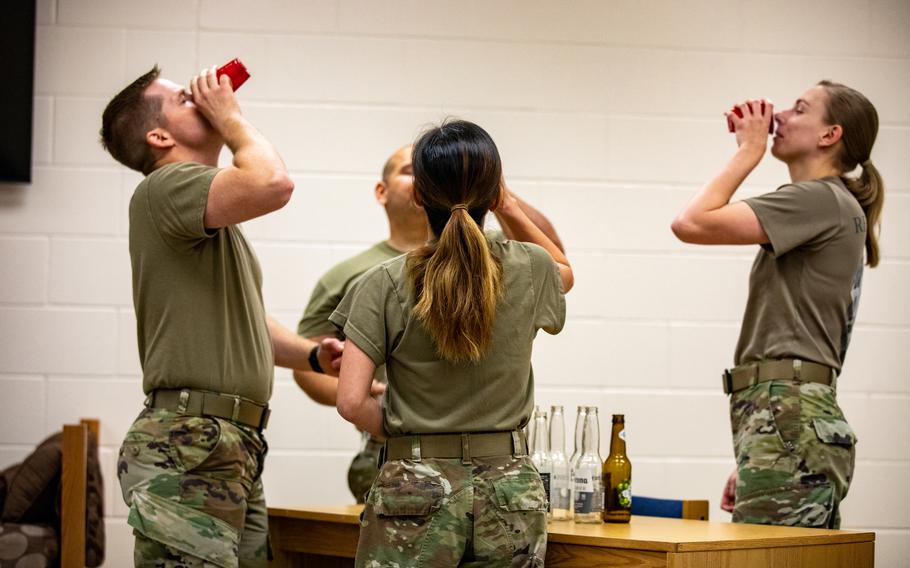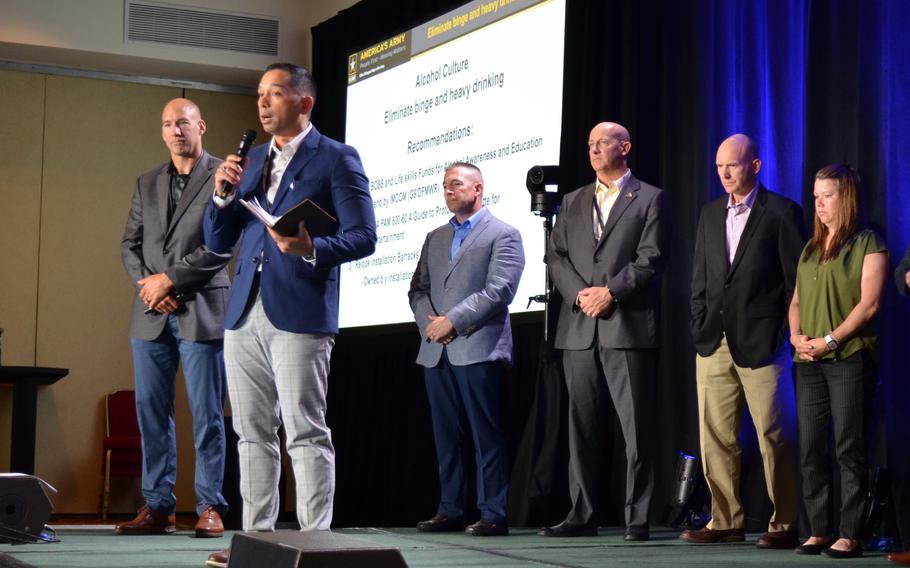
Soldiers assigned to III Armored Corps act out a scene in which they engage in drinking activities during a demonstration at the People First Center at Fort Hood, Texas, on April. 12, 2022. The People First Center is a combined training facility for units, which focuses on sexual harassment/assault response and prevention, suicide prevention, domestic violence prevention and substance abuse prevention, among other issues. (Daniel Herman/U.S. Army)
When Tyler Ewell lived in the barracks as a soldier, playing beer pong became a way to get everyone out of their rooms and talking and laughing with each other. Soldiers from different states had different rules for the game, which would spark banter as they negotiated how to play.
“As you’re making the game, you’re trying to get familiar with new people,” said 27-year-old Ewell, who left the Army about two years ago as a specialist. “You’re not just sitting around drinking by the campfire. You’re playing a competitive game against somebody that you’re bonding with. It’s somebody in your unit that you have met all of twice outside the motor pool, but you’ve been next-door neighbors for the last year and a half.”
The other soldiers who Ewell met by playing drinking games in the barracks have become lifelong friends, he said. But for all the ways alcohol can bring people together, he said he also knows there’s a dark side.
He’s seen barracks parties with alcohol help bring shy people out of their room and make friends, but he said there also have been times where he’s watched soldiers transported to a hospital for alcohol poisoning.
Last month, Sgt. Maj. of the Army Michael Grinston challenged some of the service’s top enlisted leaders to find ways to encourage more of the bonding that happens playing beer pong and less of the negative effects that alcohol can have among soldiers, particularly those younger troops living in the barracks where leaders have more control over their environment.
By curbing binge drinking, Grinston said he believes he also will be combating the military crises of sexual assault and suicide in which alcohol has been found to be a contributor, though not necessarily the cause.
Nearly 70% of incidents related to the Sexual Harassment/Assault Response and Prevention program involve alcohol, according to the December 2020 report of the Fort Hood Independent Review Committee.
The Defense Department’s Independent Review Commission on Sexual Assault in the Military reported in July 2021 that alcohol also serves as a main risk factor for suicidal behavior and domestic violence.
“In short, targeting alcohol use and misuse is a crucial component enabling primary prevention of all forms of sexual violence,” the commission wrote in its report.
Grinston introduced the task of improving the Army’s alcohol culture to a gathering of about 150 of the Army’s top enlisted leaders last month in El Paso, Texas. The group met to examine ways of reducing instances of suicide and sexual assault among soldiers from several angles.
At the end of the three-day conference, Grinston accepted at least two concepts for development that would loosen the restrictions on the amount of alcohol that soldiers can keep in their barracks and allow units to host educational alcohol activities.
“Trying to restrict the amount of alcohol that a person has in a location, that’s not having the effect [we want],” Grinston said. “[We want to teach troops] this is appropriate behavior, this is the culture in my organization.”

Sgt. Maj. of the Army Michael Grinston speaks Tuesday, June 28, 2022, during a three-day conference in El Paso, Texas, that included about 150 of the Army’s top sergeants major. At the close of the conference, Grinston selected seven initiatives to develop to improve working and living conditions for soldiers, increase retention and curb harmful behavior such as binge drinking, suicide and sexual assault and harassment. (Rose L. Thayer/Stars and Stripes)
During the past two years, the Army has been under increased scrutiny from Congress and the public to protect soldiers from sexual assault, harassment and suicide. In April 2020, Fort Hood soldier Spc. Vanessa Guillen was killed on base by a fellow soldier, and her family said she’d faced sexual harassment prior to her death.
A bill named in Guillen’s honor was signed into law and fundamentally changes the way that the Defense Department handles sexual harassment and assault reports.
Her death and the heightened attention it brought to corrosive behavior in the military led the Army to conduct an independent review at Fort Hood, with its recommendations to be implemented service wide. The Defense Department later launched an independent review of how the entire military handles sexual assault cases. The recommendations of that review are also scheduled for implementation.
Meanwhile, the number of suicides in the Army spiked during the coronavirus pandemic, particularly in remote locations such as Alaska, which has Congress debating what it can do to help.
Major policy changes take time to implement, maybe years in some cases, so Grinston has challenged enlisted leaders to find ways that generate positive change using the resources and means already available to them. He asked them to find solutions that are quick and cheap to implement. If the tests don’t work, cut it and move on. If they do work, share it with other bases.
‘What are we going to do about it?’
When it comes to alcohol, the Army has tried zero-tolerance policies and problems persist, Grinston said during last month’s conference near Fort Bliss of Army sergeants major. The group seemed skeptical of some of the ideas coming from their peers, such as loosening restrictions associated with alcohol.
“Do you think we’ve got the alcohol culture right in the Army right now?” Grinston asked of everyone at the conference.
After a pause, someone answered, “No.”
“So now the question is, what are we going to do about it?” Grinston asked.
The numbers are already trending down on alcohol-related incidents, such as drunken driving and drunken disorderly conduct, but it doesn’t mean it’s time to stop, he told them.
Since 2014, alcohol-related incidents have dropped about 40% across the Army, according to statistics discussed at the conference. However, Grinston said he is aiming to prevent other behaviors that are often tied to drinking but not necessarily caused by alcohol.
“A year from now, can you say, ‘I did everything in my power to make a more lethal, more ready unit and did I reduce those harmful behaviors?’” Grinston asked.
The leaders broke off into 10 small groups with two focused on improving the alcohol culture of the Army. Other groups looked at leader engagement and development, recruiting, retention and mentorship.
“It's not really alcohol that we're combating. It's binge drinking and heavy drinking,” said Command Sgt. Maj. Raymond Quitugua Jr. of the Army Chemical Corps at Fort Leavenworth, Kan. He served on one of those small groups.
Sifting through research on the subject, the leaders narrowed down to two root causes that lend to soldiers drinking too much — acceptance and a lack of education on how to drink moderately.
“Leaders have to stop being scared to talk about alcohol. … Right now, too many leaders are just scared to have that conversation because they think we're glorifying it. You're not glorifying, you're educating,” Quitugua said.
His group submitted some ideas that were accepted for development that mostly involved creating positive experiences or removing policies that put limits on alcohol in barracks rooms. He envisioned teaching soldiers how to order non-alcoholic drinks at a bar that aren’t obviously so, or taking them to wineries, breweries or distilleries to teach them about alcohol-content labels and increase their appreciation for quality products, not just whatever is cheapest on base.

Command Sgt. Maj. Raymond Quitugua Jr. of the Army Chemical Corps on Thursday, June 30, 2022, presents ideas to help curb binge drinking among soldiers. He took part in a three-day conference in El Paso, Texas, of the Army’s top enlisted leaders. By improving the culture around alcohol in the Army, the leaders aim to eliminate other discipline problems and harmful behaviors such as sexual assault and harassment and suicide. (Rose L. Thayer/Stars and Stripes )
The Army already provides each base up to $30,000 to train soldiers on life skills, primarily through the Better Opportunities for Single Soldiers program, Quitugua said.
“I know this sounds kind of far out there. But again, we're trying to be bold with our recommendations … to actually enact real change,” he said when presenting the ideas to the gathering. “What we're doing is we're allowing them to actually be exposed to this outside of the clubs and the bars that they're going to at night.”
Change conditions, change culture
Brandon Clark, a 31-year-old Army veteran, pushed back on the idea that acceptance and education are the major factors that lead to soldiers drinking too much. Instead, he said he and other soldiers drank more in the barracks because they were often overworked with little respite available to them at the end of the day.
“You're already irritated from a long workday and being treated like crap by senior leaders. Then you go home to the barracks where you're confined in a room that kind of looks like a prison hallway,” he said. “What are you going to do? Just drink the day away … and get ready for tomorrow.”
Clark said he and other soldiers would return to their rooms at the end of the workday and intentionally take two or three shots of alcohol so that they could not be called back to work for additional duties, which was common.
“That’s just how miserable we were,” said Clark, who left the Army as a specialist in 2017 and the National Guard about a year ago.
Removing restrictions on alcohol in the barracks would increase morale, he said. And Clark said he probably would have taken a trip to a brewery and agreed that looking at alcohol culture to indirectly combat sexual assault and suicide is a good step for Army leaders.
However, he said until the Army looks more closely at those quality-of-life issues that often lead soldiers living in the barracks to drink too much, they’ll likely continue to do it.
“The reason for the drinking is the unaddressed issues in the military with toxic leaders or the fact that barracks soldiers get treated like substandard citizens compared to the married soldiers living in on-base housing or off base,” Clark said. “There’s definitely not fair treatment.”
More leaders in the barracks
While this new approach, which is still under development, is more about empowering soldiers to make positive choices on their own, leaders at Fort Bragg, N.C., have documented success through a pilot program to increase leader presence in the barracks. The concept was generated during the 2021 sergeants major conference in Virginia.
Officials launched a program known as the Leader Engagement Tool in August 2021 that requires leaders to visit the barracks more and uses technology to track what they see and report it up the chain of command. In its first four months, the base saw a 25% overall reduction in crime, said Command Sgt. Maj. TJ Holland, the top enlisted soldier for the XVIII Airborne Corps and Fort Bragg. Some of the decreases in crime included good order and discipline incidents, drugs, physical and sexual assaults, property damage, fraud and theft.
The Leader Engagement Tool uses a smartphone application that requires the leader to be physically present in the barracks to submit a report. Those leaders can range from a staff sergeant to a colonel, Holland said.
During their patrol, the leader must scan a QR code on the wall and then answer the series of questions that pop up. The data is then instantly available in a dashboard for senior leaders to track trends and try to prevent problems before they occur, Holland said.
Initially noncommissioned officers weren’t too happy about the rotations through the barracks, but they came around after garnering some appreciation for the effort from some soldiers, he said.
“That changes the mentality from the grassroots,” Holland said. “It's provided exceptionally, overwhelming positive feedback from those soldiers knowing that their leaders are there. And it's what I can't measure is the amount of coaching and teaching and mentoring that has been going on.”
The program has since launched at Fort Drum, N.Y., and will soon launch at Fort Campbell, Ky., and Fort Polk, La., he said. To implement it across the Army, the service will need to invest in expanding the app’s platform, which is the plan, Holland said.
The engagement tool has also had a positive impact on maintenance work orders in the barracks. Requests are up between 500 and 800 per month, and the data compiled in the engagement tool allows leaders to better track each maintenance issue and provide better quality assurance.
Before any concepts to change alcohol policies can be implemented, they first must run a pilot program to test it — similar to how Fort Bragg rolled out the Leader Engagement Tool. A pilot program likely would include a time-limited easing of alcohol policies to allow leaders to review how soldiers’ behavior changes, according to Grinston’s office.
Army veteran Ewell, who has previously advocated for improving the barracks, said if leaders really want to understand the experiences of their single soldiers, they should move into the barracks for 60 days, especially those who came into the Army married and never lived there.
“Go to the barracks and live the same rules and the same day-to-day as soldiers,” he said. “You wake up some days and you don't have hot water. You have a roommate that makes a mess. You have limits on your alcohol. You have 4:30 a.m. wake-up calls … when they look at your room to make sure it's clean. … I know their work schedules are earlier and later than most of the junior enlisted. But it does affect … morale.”